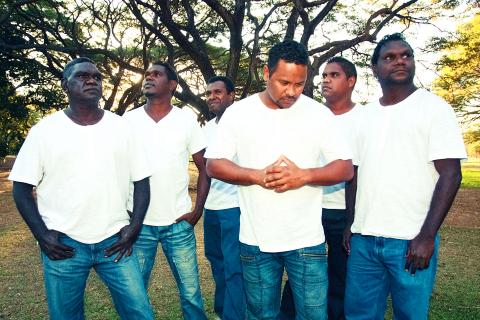Aboriginal R&B boy band B2M are used to people dancing at their concerts, but the enthusiasm of audiences in Taiwan took them by surprise.
All seven members of B2M — which stands for Bathurst to Melville — hail from the Tiwi Islands. They have just returned from headlining the Pulima Art Festival (Pulima藝術節2016), where audiences responded to their catchy songs with overwhelming gusto.
Band member Jeffrey Simon says it was “a real eye-opener” connecting with other indigenous people and cultures. The band has toured East Timor, Bali and Shanghai, but this was their first trip to Taiwan.

Photo courtesy of Skinnyfish Music Australia
“When we first went to East Timor we felt the connection to home, when we met other indigenous people, in the way they embraced us and our music. Taiwan was very similar, we found a lot of similarities in our cultures,” Simon tells Guardian Australia.
“Like, they couldn’t talk to their sisters, and we can’t talk to our sisters or mothers-in-law. The way they did their welcome to country with us was very similar ... I think the highlight was when we saw the dancers from a certain tribe from Taiwan and how they passed down their tradition to the young ones,” he says.
B2M’s songs are known for their positive messages around alcohol and drugs, but in Taiwan, the band opted for a set list that was markedly different to what they usually play in Australia, bringing out more traditional chants and more culture, Simon says.
The band got everyone up and dancing at the festival, despite warnings that Kaohsiung crowds might be a little less active, says Louise Partos, executive director of touring agency Artback NT.
There was a great connection with smaller indigenous communities that they visited in the days after the festival, where “people got up and danced straight away,” Partos says.
“Both B2M and that community performed their welcome songs and dances and thank you songs and dances. It was just beautiful to see how linked those communities were in terms of ceremonial practices and respecting each other,” Partos says. “There was a building of relationships and a recognition of oneness that I hadn’t expected.”
‘PROJECT SONGLINES’
The Taiwan trip inspired B2M’s new venture, Project Songlines, which involves mixing traditional ancient Tiwi chants with those of other indigenous cultures.
“If you bring these two ancient cultures together and mix them into a dance pop R&B mix and make it so catchy, if you’re going to play it in a nightclub, you’ll definitely connect with it,” Simon says. “But it’s got a tribal feel to it so you want to start stomping your feet and dancing.”
In order to use the traditional chants, the band had to seek permission from Tiwi elders, but Simon says “they’re all for it.”
“It’s amazing to see they understand that for our culture to survive in the new world it needs to be recorded and passed down in a different way. And from what we heard in Taiwan it’s very similar there. But they are so into it, and very excited about it,” he says.
B2M’s positive messages around drugs and alcohol are nevertheless very important to them.
“It’s such a huge problem, and not just for us,” Simon says. “Hopefully someone can take over or pick up on it, because there needs to be songs about that on mainstream radio.”
The band has a big following, particularly among Indigenous Australian communities, and feels a responsibility to the younger generations.
“We’re all fathers in the band, and kids are our main passion,” Simon says. “Back in 2004 there was time when we almost broke up but the kids are the ones that kept us going. The kids are now over the age of 18 and they’ve been singing our songs since they were like 12 years old.”
The band is “so not into love songs,” he says.
“On mainstream radio there’s a lot of songs about the booty and stuff, which is great, but we understand that as a band we don’t have long. Bands do break up eventually so we try to make as much impact as we can in the time we’ve got,” he says.
B2M TAIWAN TOUR
Nov. 4 Appeared at the Kaohsiung Museum of Fine Arts as part of the Pulima Festival
Nov. 6 Visited Taiwan Indigenous Peoples Cultural Park in Pingtung Count
Nov. 7 Performed and gave a workshop at Taitung’s Tie Hua Village
Nov. 8 and Nov. 9 Traveled to Hualien County and sang at the Presbyterian Church in Fuli and at National Dong Hua University
Nov. 12 Performed at the International Pavilion of Indigenous Arts and Cultures in Taipei
Source: Australian Office, Taipei

As I finally slid into the warm embrace of the hot, clifftop pool, it was a serene moment of reflection. The sound of the river reflected off the cave walls, the white of our camping lights reflected off the dark, shimmering surface of the water, and I reflected on how fortunate I was to be here. After all, the beautiful walk through narrow canyons that had brought us here had been inaccessible for five years — and will be again soon. The day had started at the Huisun Forest Area (惠蓀林場), at the end of Nantou County Route 80, north and east

Specialty sandwiches loaded with the contents of an entire charcuterie board, overflowing with sauces, creams and all manner of creative add-ons, is perhaps one of the biggest global food trends of this year. From London to New York, lines form down the block for mortadella, burrata, pistachio and more stuffed between slices of fresh sourdough, rye or focaccia. To try the trend in Taipei, Munchies Mafia is for sure the spot — could this be the best sandwich in town? Carlos from Spain and Sergio from Mexico opened this spot just seven months ago. The two met working in the

Exceptions to the rule are sometimes revealing. For a brief few years, there was an emerging ideological split between the Democratic Progressive Party (DPP) and Chinese Nationalist Party (KMT) that appeared to be pushing the DPP in a direction that would be considered more liberal, and the KMT more conservative. In the previous column, “The KMT-DPP’s bureaucrat-led developmental state” (Dec. 11, page 12), we examined how Taiwan’s democratic system developed, and how both the two main parties largely accepted a similar consensus on how Taiwan should be run domestically and did not split along the left-right lines more familiar in

A six-episode, behind-the-scenes Disney+ docuseries about Taylor Swift’s Eras Tour and Rian Johnson’s third Knives Out movie, Wake Up Dead Man, are some of the new television, films, music and games headed to a device near you. Also among the streaming offerings worth your time this week: Chip and Joanna Gaines take on a big job revamping a small home in the mountains of Colorado, video gamers can skateboard through hell in Sam Eng’s Skate Story and Rob Reiner gets the band back together for Spinal Tap II: The End Continues. MOVIES ■ Rian Johnson’s third Knives Out movie, Wake Up Dead Man